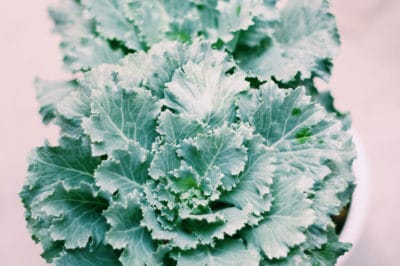Choosing Kale Varieties for Growing Indoors
Kale can be a large plant for growing indoors. Some varieties of kale grow to a height of 2 to 3 feet and measure 2 feet in diameter.
Instead of letting your kale grow to maturity, you can grow kale sprouts (micro greens) or baby kale.
You can also choose one of the shorter or dwarf varieties of kale. These include:
- Dwarf Blue Curled — 12 inches tall (also known as Dwarf Blue Curled Scotch, Dwarf Blue Scotch, Blue Curled Scotch, and Dwarf Blue Curled Vates)
- Dwarf Siberian — 16 inches tall
- Improved Dwarf Siberian
Choosing Pots for Kale
A shallow container works best for kale sprouts, but otherwise, you can grow kale in almost any container. If you need to provide your kale with a light source, though, all of the containers will need to be the same height so that there will be an equal distance between the light source and each plant.
Providing Light for Kale
Kale needs about eight hours of light each day. The best light source is a south-facing window, but some houses, apartments, and condos lack a sunny area.
If you don’t have sufficient light, you still don’t have to invest in an expensive grow light system, but you do need to make sure that the lighting you choose provides light from across the entire spectrum, just as sunlight does.
Red Light
Light in this range of the spectrum stimulates root development, which makes it helpful for starting kale seeds.
Blue Light
Blue light encourages kale to produce leaves and strong stalks. Without sufficient blue light, your kale will grow too tall with thin stalks that can collapse under the weight of the plant.
Choosing the Right Bulbs
Incandescent bulbs don’t produce a sufficient amount of light across the full spectrum. In addition, because the light source should be kept close to the plants, at a height of 4 inches, incandescent bulbs produce so much heat that they can scorch leaves.
Cool white fluorescent lights provide a good balance of light for starting seeds. However, standard fluorescent bulbs don’t provide light with enough intensity for plant growth.
T5 high-output fluorescent lights produce three times as much light as standard fluorescents without the heat created by metal halide (HID) lights. With the reduction in heat, the light can be closer to the plants.
T5 3000-K lamps provide light at the red end of the spectrum while T5 6500-K lamps cover the blue end of the spectrum. You can mix these to create the best “lighting recipe” for your kale at each stage of growth.
Double-ended HPS or high-pressure sodium lights also produce high-intensity light, but the red and far-red end of the spectrum may need to be supplemented with LED lighting, especially at the end of the day to simulate the effects of sunset. Simulating sunset signals plants to begin shutting down photosynthesis for the night. If plants are suddenly plunged into darkness when the lights are turned off, they can take several hours to respond.
High intensity LEDs greatly reduce heat and energy costs. Manufacturers are producing high-intensity LEDs in colors that range from the far-red to ultraviolet and even creating customized “lighting recipes” at no extra charge.
HID lights remain the standard lighting source for now, but watch the developments in the other options.
Setting Up Your Lighting Source
You can use timers to control your light source. You will also need to be able to adjust its height as your kale grows.
Watering Kale Indoors
Because the light source needs to be so close to the kale, the safest and least awkward way to water your kale is to set up a drip line. Just allow the surface of the potting mix to dry out between each watering while making sure that the soil retains moisture at a depth of about 1 inch.
